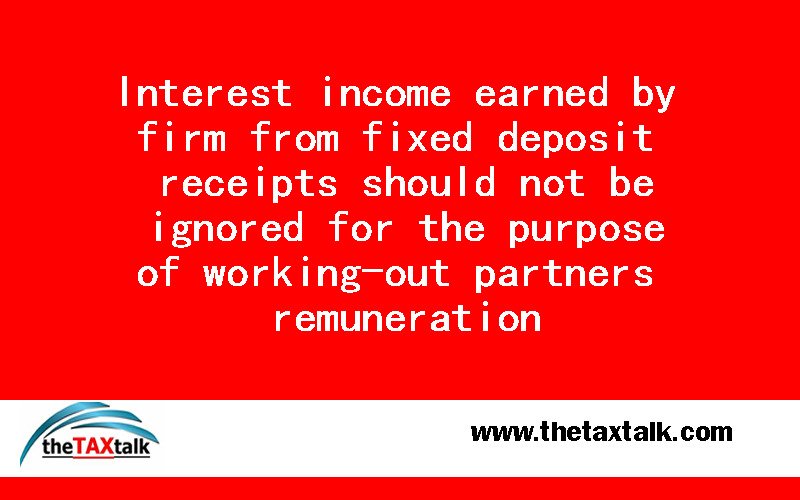![]()
Interest income earned by firm from fixed deposit receipts should not be ignored for the purpose of working-out partners remuneration
Short Overview As per Explanation 3 of section 40(b), AO did not get jurisdiction to go behind net profit shown by Profit and Loss Account, except to the extent of the adjustments provided in the Explanation 3, nor he was empowered to decide under which head the income was to be taxed. The net profit as shown was not to be allocated into different components. Accordingly, addition was deleted.
Assessee-firm was engaged in the manufacturing of aromatic chemicals. AO noted that the total income of assessee included dividend income of Rs. 377, interest on deposit of Rs. 4,51,820, interest on income-tax refund of Rs. 28,322 and interest on recurring deposit account of Rs. 42,602, which were covered under the head “Income from other sources”. AO noted that these incomes were not directly related to business income of assessee but derived from other sources, therefore these amounts, aggregating to Rs. 5,23,121, were required to be deducted from net profit to compute book profit. Thus, the book profit was to be derived to Rs. 7,89,025 from which admissible remuneration as per under section 40(b)(v) would be at Rs. 3,68,110. However, AO noticed that the remuneration paid to partner was Rs. 5,92,357. So, there was an excess payment of remuneration amounting to Rs. 2,24,247 (Rs. 5,92,357 – Rs. 3,68,110). Accordingly, AO made addition.
It is held that It is abundantly clear that for the purpose of section 40(b)(v) read with Explanation, there cannot be separate method of accounting for ascertaining net profit and/or book profit. Therefore, interest income earned by assessee-firm from fixed deposit receipts should not be ignored for the purpose of working-out book profit to ascertain ceiling of partners remuneration. For the purpose of ascertaining such ceiling of the partners remuneration on the basis of book profit, profit would be in the profit and loss account and was not to be classified in different heads of income under section 40. Interest income, therefore, could not be excluded for the purposes of determining allowable deduction of remuneration paid to the partners under section 40B. For purpose of Explanation 3 to section 40(b)(v), assessee took into consideration its net profit as shown in the profit and loss account which included:– (1) Dividend income : (2) Interest on deposits : (3) Interest on Income Tax Refund : (4) Interest on recurring deposit : Although these incomes of assessee under consideration, were shown under different heading but same were classified under the heading as shown appearing in the matter of computation book profit in terms of Explanation 3 of section 40(b)(v) as said Explanation provides for taking the net profit as shown in the profit and loss account, and not the Profits computed under the head profit and gains on business or profession . Hence, these items were not be excluded while computing book profit for the purpose of partners remuneration. As per Explanation 3 of section 40(b), AO did not get jurisdiction to go behind net profit shown by Profit and Loss Account, except to the extent of the adjustments provided in the Explanation 3, nor he was empowered to decide under which head the income was to be taxed. The net profit as shown, was not to be allocated into different components. Accordingly, addition was deleted.
Decision: In assessee s favour.
Followed: CIT v. J.J. Industries (2013) 358 ITR 531 (Guj.) : 2013 TaxPub(DT) 1883 (Guj-HC) and Md. Serajuddin & Bros. v. CIT (2012) 210 Taxman 84 (Cal-HC) : 2012 TaxPub(DT) 2885 (Cal-HC).
IN THE ITAT, SURAT BENCH
PAWAN SINGH, J.M. & A.L. SAINI, A.M.
Mac Industries v. ITO
IT Appeal No. 1036 (Ahd) of 2016
A.Y. 2009-10
19 October, 2020
Appellant by: Hardik Vora, A.R.
Respondent by: Anupama Singhla, Sr. D.R.
ORDER


